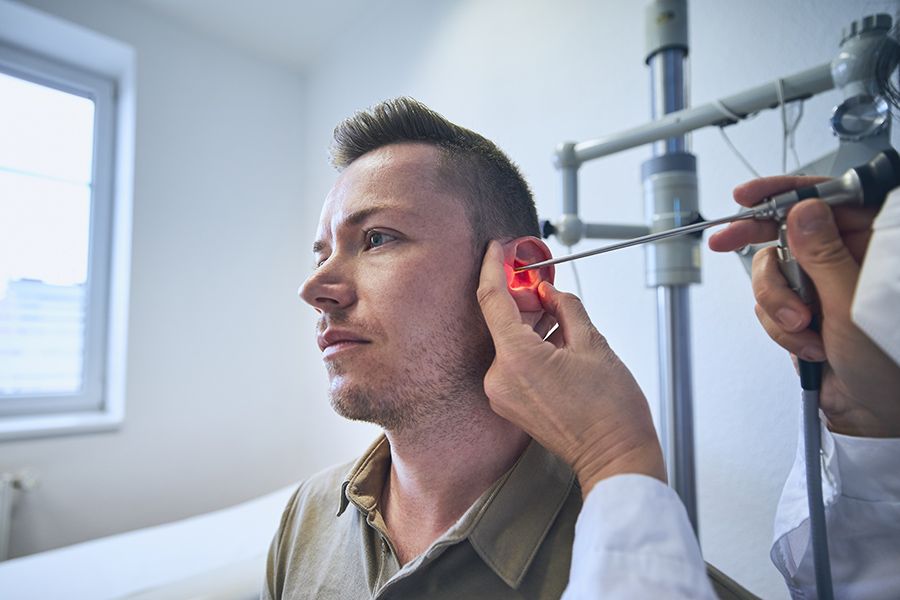Introduction
Otosclerosis, a term deriving from ‘oto’ meaning ear and ‘sclerosis’ meaning hardening, is a lesser-known medical condition that primarily affects the ear’s bones. This degenerative disorder is quite common, yet not everyone who has been diagnosed with it completely comprehends what it entails. For those affected by it, knowledge is power, as it provides them the ability to understand the situation, take appropriate measures, and better manage their health.
The goal of this article is to delve into the various aspects of otosclerosis, providing an in-depth overview of the condition, an understanding of its anatomy and physiology, the risk factors associated with it, and the genetics involved. In addition, the article will explore the relationship between otosclerosis and tinnitus, a frequent symptom of the disease. We aim to illuminate this often misunderstood condition, offering valuable information for adults diagnosed with otosclerosis and their loved ones.
Moreover, this blog post aims to bridge the gap between medical jargon and common understanding, with detailed explanations, metaphors, and examples. We’ll be navigating this echoing labyrinth of information together, from understanding the mechanics of this condition to examining the symptoms, risks, and genetic links. Ultimately, we hope this guide becomes an empowering resource for those living with otosclerosis.
In this comprehensive exploration, the insights gleaned will foster a deeper understanding, enabling those living with otosclerosis to gain a clearer perspective of the situation. So, let’s delve into this echoing labyrinth of otosclerosis, decoding the noise to help you find the silence.
Otosclerosis An In-depth Overview
In our pursuit of understanding otosclerosis, it is essential to start with a detailed overview. Otosclerosis is a progressive hearing condition that predominantly affects the stapes, one of the tiny bones in the middle ear. Over time, an abnormal bone growth develops around the stapes, causing it to become less flexible and impeding the transmission of sound to the inner ear.
The exact cause of otosclerosis remains a mystery. However, a combination of genetic and environmental factors is believed to contribute to its occurrence. It is estimated that roughly half a million people in the United States are affected by otosclerosis, with the condition often beginning in early to middle adulthood.
In terms of symptoms, the initial and most common one is progressive hearing loss. This typically starts as difficulty hearing low-frequency sounds or whispers. Additionally, otosclerosis can cause tinnitus, a sensation of ringing or buzzing in the ear, and in rare cases, it can also cause vertigo, a sensation of being unsteady or spinning.
While otosclerosis is currently incurable, several treatments exist to manage the symptoms effectively. These range from hearing aids, which amplify sound, to surgery such as stapedectomy, where the affected bone is removed and replaced with a prosthetic.
The Anatomy and Physiology of Otosclerosis
Understanding otosclerosis necessitates a closer look at the ear’s anatomy and the physiological changes induced by the condition. The human ear is divided into three sections: the outer ear, the middle ear, and the inner ear. Sound waves enter through the outer ear and are funneled to the eardrum, causing it to vibrate.
These vibrations are then transferred through three tiny bones in the middle ear, known as the ossicles — the malleus (hammer), incus (anvil), and stapes (stirrup). This chain of bones amplifies the sound waves and transmits them to the fluid-filled cochlea in the inner ear, where they are converted into electrical signals for the brain to interpret.
In otosclerosis, abnormal bone growth around the stapes in the middle ear impedes its movement, thus interfering with the transmission of sound vibrations to the inner ear. This is what primarily leads to hearing loss in individuals with otosclerosis.
Over time, the condition might progress, with the abnormal bone growth extending to the cochlea. This phenomenon, termed cochlear otosclerosis, can result in sensorineural hearing loss, a type of hearing loss associated with damage to the inner ear or auditory nerve.
Identifying the Risk Factors Associated with Otosclerosis
Recognizing the risk factors of otosclerosis can be crucial to its early detection and management. While the exact cause of otosclerosis remains unknown, several factors are associated with a heightened risk of developing the condition.
First and foremost, there is a significant genetic component to otosclerosis. Individuals with a family history of the condition are ten to twenty times more likely to develop it than those without. This suggests that otosclerosis can be inherited, though the specific genes involved are still under investigation.
Other factors also come into play. For instance, the condition tends to be more common in women than in men. Pregnancy is another key risk factor, with many women experiencing a worsening of their symptoms during this period. This has led to speculation that hormonal changes could play a role in otosclerosis.
While otosclerosis predominantly affects Caucasians, it is relatively rare in people of Japanese and South American descent. This suggests that race or ethnicity may also be a factor in the disease’s prevalence.
Tweak Digital Hearing Amplifier
Experience the epitome of sophisticated sound with Tweak, the revolutionary device that brings a new dimension to your auditory experience. Harnessing the power of innovative patented technology, Tweak offers you the freedom to fine-tune your hearing with a diverse range of amplification options. Whether you prefer a subtle enhancement or a more pronounced boost, Tweak empowers you to effortlessly customize your acoustic world.
Crafted with meticulous care and expertise, Tweak represents the brilliant collaboration between an esteemed audiologist and a team of dedicated acoustic engineers. Their collective passion for impeccable sound quality shines through in every detail of this remarkable device. Designed to elevate your hearing capabilities across any environment, Tweak utilizes cutting-edge technology to ensure that you can fully engage with the sounds that matter most to you.
Unlock the extraordinary potential of affordable sound quality with Tweak. By leveraging the latest advancements in digital technology, this ingenious device delivers an auditory experience that rivals that of prescription hearing aids. With premium-grade components at its core, Tweak offers you uncompromising performance without breaking the bank. Immerse yourself in a world of enhanced sound, where clarity and richness seamlessly merge to create an exceptional listening experience.
Lipo-Flavonoid Plus, Tinnitus Relief for Ringing Ears
Considered the most effective over-the-counter solution by ENTs, this product comes highly recommended by doctors for reducing ear ringing. Its effectiveness has been acknowledged and trusted by medical professionals in the field.
Please note that exposure to heat or sunlight may cause melting or damage to the product. To ensure the product’s integrity, customers are advised to be present during the delivery process.
Formulated with a natural lemon bioflavonoid complex, this product contains a rich blend of essential vitamins and nutrients such as Vitamins C, B1, B2, B6, B12, Calcium, Choline Bitartrate, Inositol, Niacin, and Pantothenic Acid. These ingredients provide vital nutritional support for the inner ear, making it beneficial for individuals with tinnitus and Meniere’s syndrome.
Demystifying the Genetics of Otosclerosis
Given the hereditary nature of otosclerosis, understanding the genetics behind the condition is a significant step toward demystifying it. Researchers believe that otosclerosis is likely caused by a combination of genetic and environmental factors.
Otosclerosis tends to run in families, indicating a strong genetic component. Several genes have been associated with the condition, though no single gene has been identified as the definitive cause. Instead, it appears that a combination of variants in multiple genes, each contributing a small amount, increases the risk of developing otosclerosis.
One example is the gene coding for a protein called TGBF1, which regulates the growth and development of bone and cartilage. Some studies suggest that certain variants of this gene may increase the risk of otosclerosis. However, this is just one piece of the puzzle, and more research is required to fully understand the genetic complexity of otosclerosis.
QUIZ - CURRENT RESEARCH ON HEARING LOSS
The Relationship Between Otosclerosis and Tinnitus
There is a notable connection between otosclerosis and tinnitus, with many otosclerosis patients reporting tinnitus symptoms. Tinnitus is described as a ringing, buzzing, or hissing sound in the ears that others can’t hear. It is essentially a symptom of an underlying condition, otosclerosis being one of them.
In otosclerosis, the abnormal bone growth restricts the movement of the stapes, disrupting the normal transmission of sound vibrations to the inner ear. This can cause the perception of sound when none is present, resulting in tinnitus.
Furthermore, tinnitus experienced by individuals with otosclerosis often worsens in quiet environments or at night when background noise is minimal. This can significantly impact the quality of life, causing distress, difficulty sleeping, and concentration problems. Although tinnitus is currently incurable, various management strategies can help individuals cope with the symptoms effectively.

Tinnitus Treatments: Examining Supplements, Technology
Another person found alleviation in running, saying it assisted him reclaim a sense of control. Still one more individual explained the experience as “amazing”– a

“What Did You Say?” Protect Your Hearing – Hearing Loss Is Irreversible
Introduction Hearing loss is a common and often overlooked health issue that affects millions of people worldwide. Whether it is due to exposure to loud
Conclusion
Understanding otosclerosis is a journey that begins with recognizing its symptoms and tracing the course of the disease through a comprehensive understanding of its anatomy and physiology. The landscape of otosclerosis is filled with genetic markers and risk factors that provide insight into the mechanisms and triggers of the condition. The relationship between otosclerosis and tinnitus illuminates the extensive impact of the condition on the quality of life of those affected, further emphasizing the importance of proper management and treatment.
With our exploration of otosclerosis, we have painted a clearer picture of this complex condition, shedding light on the fundamental aspects of its mechanics, risk factors, genetics, and relation to tinnitus. This understanding arms us with the ability to better navigate the echoing labyrinth that otosclerosis often represents.
Remember, every journey starts with a single step. By taking the time to understand otosclerosis, you’ve already taken that first step. With this newfound knowledge, managing otosclerosis can become less daunting, less overwhelming. The labyrinth may seem less intricate, and the echoes may seem less loud.
In the end, understanding otosclerosis isn’t about eliminating the echoes entirely but learning to navigate them, to understand their rhythm, and to find peace amid the noise. As we’ve uncovered, otosclerosis is not just about hearing loss. It’s about the human spirit and the will to understand, cope, and persevere. The echoes may be a part of your journey, but they don’t define your destination.
Above all, remember that you are not alone in this journey. With a vast community of individuals experiencing the same echoes, there’s always someone to lend a listening ear, provide advice, or just be there for you. Together, we can navigate the echoing halls of otosclerosis and find the silence within the noise.








